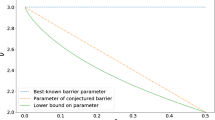Abstract
Recently a number of papers were written that present low-complexity interior-point methods for different classes of convex programs. The goal of this article is to show that the logarithmic barrier function associated with these programs is self-concordant. Hence the polynomial complexity results for these convex programs can be derived from the theory of Nesterov and Nemirovsky on self-concordant barrier functions. We also show that the approach can be applied to some other known classes of convex programs.
Similar content being viewed by others
References
F. Alizadeh, “Optimization over the positive definite cone: interior-point methods and combinatorial applications,” in: P. Pardalos, ed.,Advances in Optimization and Parallel Computing (North-Holland, Amsterdam, 1992) pp. 1–25.
D. den Hertog,Interior Point Approach to Linear, Quadratic and Convex Programming: Algorithms and Complexity (Kluwer Academic Publishers, Dordrecht, 1994).
D. den Hertog, C. Roos and T. Terlaky, “On the classical logarithmic barrier method for a class of smooth convex programming problems,”Journal of Optimization Theory and Applications 73 (1) (1992) 1–25.
R.J. Duffin, E.L. Peterson and C. Zener,Geometric Programming (Wiley, New York, 1967).
A.V. Fiacco and G.P. McCormick,Nonlinear Programming, Sequential Unconstrained Minimization Techniques (Wiley, New York, 1968).
R. Frisch, “The logarithmic potential method for solving linear programming problems,” Memorandum, University Institute of Economics, Oslo, Norway, 1955.
C.-G. Han, P.M. Pardalos and Y. Ye, “On interior-point algorithms for some entropy optimization problems,” Technical Report CS 91-02, Computer Science Department, Pennsylvania State University, University Park, PA, 1991.
P. Huard, “Resolution of mathematical programming with nonlinear constraints by the methods of centres,” in: J. Abadie, ed.,Nonlinear Programming (North-Holland, Amsterdam, 1967) pp. 207–219.
F. Jarre, “The method of analytic centers for smooth convex programs,” Ph.D. Thesis, Institut für Angewandte Mathematik und Statistik, Universität Würzburg, Germany, 1989.
F. Jarre, “Interior-point methods for convex programming,”Applied Mathematics and Optimization 26 (1992) 287–311.
F. Jarre and M.A. Saunders, “Practical aspects of an interior-point method for convex programming,”SIAM Journal on Optimization, to appear.
K.O. Kortanek and H. No, “A second order affine scaling algorithm for the geometric programming dual with logarithmic barrier,”Optimization 23 (1990) 501–507.
K.O. Kortanek and J. Zhu, “A polynomial barrier algorithm for linearly constrained convex programming problems,”Mathematics of Operations Research 18 (1993) 116–128.
I.J. Lustig, R.E. Marsten and D.F. Shanno, “On implementing Mehrotra's predictor-corrector interior point method for linear programming,”SIAM Journal on Optimization 2 (1992) 435–449.
S. Mehrotra and J. Sun, “An interior point algorithm for solving smooth convex programs based on Newton's method,”Contemporary Mathematics 114 (1990) 265–284.
R.D.C. Monteiro and I. Adler, “An extension of Karmarkar type algorithms to a class of convex separable programming problems with global rate of convergence,”Mathematics of Operations Research 15 (3) (1989) 408–422.
Y.E. Nesterov and A.S. Nemirovsky,Interior Point Polynomial Algorithms in Convex Programming, SIAM Studies in Applied Mathematics, Vol. 13 (SIAM, Philadelphia, PA, 1994).
E.L. Peterson and J.G. Ecker, “Geometric programming: duality in quadratic programming andl p approximation I,” in: H.W. Kuhn and A.W. Tucker, eds.,Proceedings of the International Symposium of Mathematical Programming (Princeton University Press, Princeton, NJ, 1970) pp. 445–479.
E.L. Peterson and J.G. Ecker, “Geometric programming: duality in quadratic programming andl p approximation II,”SIAM Journal on Applied Mathematics 17 (1969) 317–340.
E.L. Peterson and J.G. Ecker, “Geometric programming: duality in quadratic programming andl p approximation III,”Journal of Mathematical Analysis and Applications 29 (1970) 365–383.
J. Renegar, “A polynomial-time algorithm, based on Newton's method, for linear programming,”Mathematical Programming 40 (1) (1988) 59–93.
T. Terlaky, “Onl p programming,”European Journal of Operational Research 22 (1985) 70–100.
Y. Ye and F. Potra, “An interior-point algorithm for solving entropy optimization problems with globally linear and locally quadratic convergence rate,” Working Paper Series No. 90-22, Department of Management Sciences, University of Iowa, Iowa City, IA, 1990; also:SIAM Journal on Optimization, to appear.
S. Zhang, “The convergence property of Iri-Imai's algorithm for some smooth convex programming problems,” Research Memorandum no. 485, Institute of Economic Research, Faculty of Economics, University of Groningen, Netherlands, 1992.
J. Zhu, “A path following algorithm for a class of convex programming problems,”Zeitschrift für Operations Research 36 (4) (1992) 359–377.
Author information
Authors and Affiliations
Additional information
This author's research was supported by a research grant from SHELL.
On leave from the Eötvös University, Budapest, Hungary. This author's research was partially supported by OTKA No. 2116.
Rights and permissions
About this article
Cite this article
den Hertog, D., Jarre, F., Roos, C. et al. A sufficient condition for self-concordance, with application to some classes of structured convex programming problems. Mathematical Programming 69, 75–88 (1995). https://doi.org/10.1007/BF01585553
Received:
Revised:
Issue Date:
DOI: https://doi.org/10.1007/BF01585553




